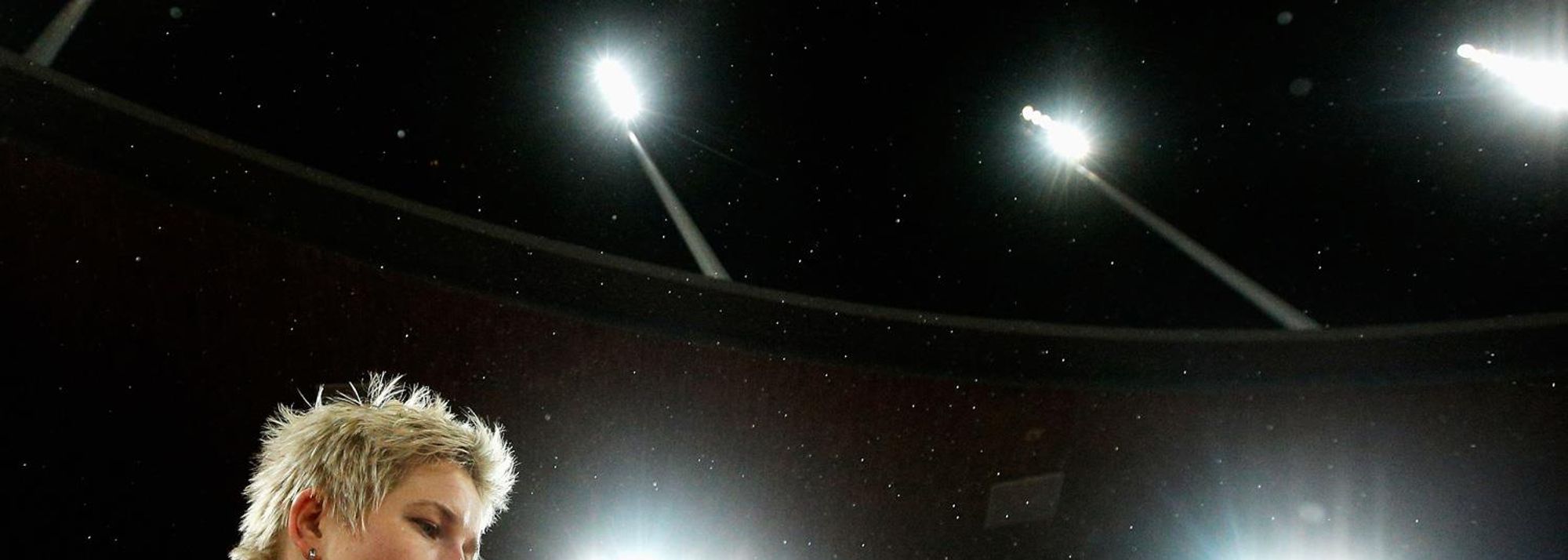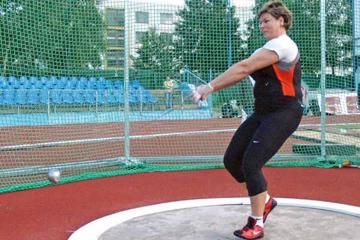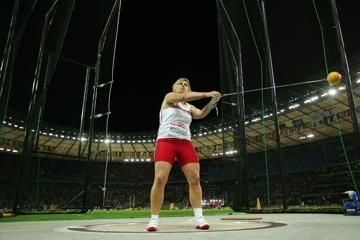Polish hammer thrower Anita Wlodarczyk (© Getty Images)
When Anita Wlodarczyk finished ahead of fellow Polish hammer thrower Kamila Skolimowska at the 2008 Beijing Olympics, little did she know that it would be the last time she competed against her friend and compatriot.
Skolimowska was the more experienced of the two, having won the Olympic title eight years earlier at the age of 17 and boasting a PB that was four metres farther than Wlodarczyk’s. But Skolimowska failed to record a valid throw in the final, while Wlodarczyk finished a respectable sixth on her Olympic debut.
Six months later, Skolimowska suddenly and unexpectedly died at the age of 26 due to a blood clot.
“She helped me a lot in my Olympic debut,” said Wlodarczyk. “She congratulated me and said I had to worthily represent my country. And I still do my best to fulfil that responsibility.”
Four years later, at the London 2012 Olympics, Wlodarczyk wore throwing shoes and gloves that used to belong to her old friend, given to her by Skolimowska’s family.
“When I entered the Olympic stadium in London, I asked Kamila to be with me,” said Wlodarczyk, who took silver at those Games. “I won the medal thanks to her and I dedicated it to her.”
Ever since Skolimowska’s death, Wlodarczyk had formed a close bond with the former Olympic champion’s family and she visits them whenever she is in their home town of Warsaw.
“After Kamila died, we were left with tons of throwing equipment, good quality professional stuff,” said Skolimowska’s father, Robert Skolimowski. “I divided it among several promising girls, but Anita received the best part.
“We watched the London Olympic final as if our daughter was in it. We cried from excitement, jumped with joy and popped champagne at the end. Exactly how we used to.”
When she landed back in Poland after the London Olympics, Wlodarczyk was greeted at the airport by Skolimowski with 77 roses, one for each metre she threw in the British capital.
“Anita competing at the London Olympics was very valuable for us and a great pleasure to watch,” added Skolimowski. “Kamila used to say she would call it a career after London and focus on family. Life went a different way, but with her shoes and gloves being worn by Anita, she had a symbolic presence. Somehow, we feel satisfied; as if a chapter has been closed.
Breakthrough in Berlin
The year in which Skolimowska died coincided with the season when Wlodarczyk’s career began to take off.
Aged 23 at the time, Wlodarczyk went into 2009 with a PB of 72.80m. By the end of the year, she was the world champion and world record-holder.
Before competing at the IAAF World Championships in Berlin, Wlodarczyk had improved her PB on five occasions and went to the German capital with a best of 77.20m and a string of seven victories. Many still favoured the home favourite Betty Heidler, but Wlodarczyk pulled out a 77.96m throw in the second round to take gold with a world record. So exuberant was her celebration, she injured her ankle in the process.
It was the first of three world records and three major titles for Wlodarczyk.
She extended her world record to 78.30m in June 2010, but just like before, she injured herself in the wake of that performance and could only finish third at the European Championships in Barcelona.
The back injury lingered throughout 2011 and she finished fifth at that year’s World Championships, but she was back to her best in 2012, winning the European title before going on to take Olympic silver.
Another silver medal followed in 2013, when she set a personal best of 78.46m at the World Championships. Earlier this year she improved on that mark by 30 centimetres to successfully defend her European title; a prelude to her world record two weeks later.
Third time lucky
Unlike her previous two world records, when Wlodarczyk threw 79.58m in Berlin this September, it wasn’t followed by an injury. This time, the injury came several months prior.
Her winter training started, as it always does, in Cetniewo in Poland, where she trained for two months. She then went to Stellenbosch in South Africa for one month, and then to Chula Vista in the US. It was there where she picked up a knee injury and missed six weeks of training.
“I started training in mid-May and my first competition was Ostrava in June,” she said. “Normally I start to compete a month earlier or even more. But who knows what would have happened had I been able to train all that time? Maybe that six-week pause helped. I couldn’t wait to start training again; I had double the motivation.”
Once her season got underway, no one would have known about her injury troubles. After finishing second in Ostrava with a respectable 76.41m, she won all of her other competitions in 2014, including the European Championships.
“After the injury, I was worried I wouldn’t be fit for the European Championships,” she said. “Maybe had I started training two weeks earlier, perhaps the world record would have happened in Zurich. When it didn’t happen there, I really wanted to do it at the Skolimowska Memorial meeting but it was so stressful that it didn’t happen, so when I went to Berlin I thought that it must be third-time lucky. I told myself, ‘if not now, then when?’
“I was so happy to break it there,” she added. “That stadium holds special memories for me because it was where, five years earlier, I broke the world record to win the world title. After losing my world record three years ago, it was really nice to have it back again.”
But less than 24 hours before the competition, Wlodarczyk was worried that she might not be at her best.
“The day before, I went shopping for three hours and I was worried my legs would be tired, so I went back to the hotel to rest. The competition was held during the day time instead of the evening, so I wasn’t sure if I’d feel different, but I arrived at the stadium and saw 50,000 fans who were cheering – not just for Betty (Heidler) but for me as well – and I also saw my family, who travel to most of my competitions.”
At the end of the competition, Wlodarczyk had become the only athlete to set a world record in an outdoor track and field event in 2014.
Quest to become first 80-metre thrower
Before she started in athletics, Wlodarczyk was a speedway cyclist and won team gold at the 1998 European Youth Championships. At 13 years old, she was the youngest – and the only female – on the team. Her experience in that sport, she says, helped to build strength in her legs from an early age.
But her injury problems in 2010 and 2011 meant that she was unable to lift heavy weights. “In training, my biggest focus is on technique,” said Wlodarczyk, who is coached by former hammer thrower Krzysztof Kaliszewski.
“I know I’m much weaker than my rivals. I only squat 150kg, which is nothing compared to other hammer throwers, but I can’t do anything about that. It means I simply have to focus on what I can do, which is technique and speed. I do little gym work, but that doesn’t mean it’s wrong.”
Although she is keen to regain her world title next year in Beijing, her main focus is becoming the first woman to throw farther than 80 metres. She is now less than half the length of a hammer away from that goal.
She has in fact already surpassed that mark, but when she did so, unfortunately her hammer landed outside the sector. German analysts worked out that her foul in the final round of this year’s European Championships was about 80.30m. Now she wants to do it officially.
“Breaking the world record makes me feel that 80 metres is definitely possible,” said Wlodarczyk, who has surpassed the 76, 77 and 78-metre barriers more times than any other woman in history. “It’s nice to have broken the world record for a third time, and hopefully I’ll hold on to it for much longer than before. I dream of being the first woman to throw 80 metres.
“I know that there’s still room for improvement. I know that 80 metres is possible; perhaps even 81.50m.
“A world record means more to me than being a world champion,” she added. “Your reign as a world champion only lasts for two years, but you can be a world record-holder for much longer than that.”
And what better setting to achieve such a feat than the venue for next year's World Championships in Beijing, the Birds Nest Stadium; the location of Wlodarczyk's final competition against Skolimowska.
Jon Mulkeen and Marta Mikiel for the IAAF















